by Tom Gaylord, a.k.a. B.B. Pelletier
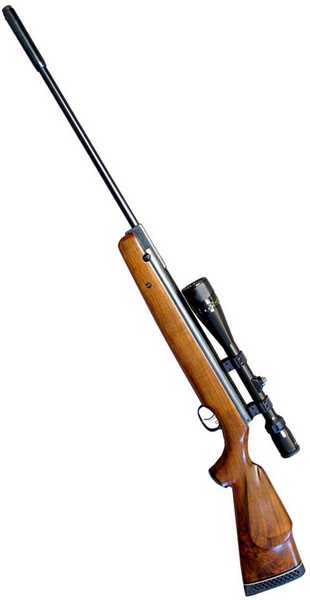
My 18-year-old Beeman R1 with its Maccari custom stock and Bushnell 6-18x Trophy scope is a thing of beauty.
You’ll notice that I’m signing in differently today. I’ve decided to start using my real name along with my pen name. I’m doing this because some people are confused about who I am, and I don’t want there to be any confusion. From now, I’ll sign in this way. You can refer to me as Tom or B.B., just as you always have, but I’ll always answer as B.B.
Today’s the day we look at how the Vortek adjustable muzzlebrake helps control pellet dispersion for the Beeman R1 air rifle. It has been a very long time since I tested this brake, so I didn’t remember how effective it was. This test was a learning experience for me, too.
At least one reader suggested that I test the brake with all three pellets, but that would have taken much longer than I had for this test. As it was, I wound up shooting seven 10-shot groups that really fatigued me by the time it was over.
I decided to test just one pellet — the H&N Baracuda Match that I said seemed to be the best pellet the last time I shot the gun. The only thing I changed during most of this test was the muzzlebrake. The scope and type of artillery hold stayed the same, except for at the end of the test, which I will explain when we come to it.
I also used the Michael Jackson artillery hold that was recommended by blog reader mikeiniowa. That’s where you wear a glove on your off hand, so the stock can easily slide on your open palm. It’s a bit quirky, and at the end of the test I have to say that it didn’t seem to make a bit of difference, but perhaps it did help me feel the rifle’s weight better. And that did lead to an alteration in my artillery hold, but that’s yet to come.
I added the cotton glove to make the Michael Jackson artillery hold.
First group
The first group was fired with the muzzlebrake set where it was for the Part 3 test. Since I used the same pellets as were in Part 3, I expected to see a group of about the same size. What I did not expect was to see a group that looked exactly like the first group in the last accuracy test, but that’s what happened. This one measured 1.269 inches between the centers of the two widest shots, which is considerably larger than the last test with the same H&N Baracuda Match pellet. Eight of the shots landed in a much tighter group that measured 0.55 inches between centers.
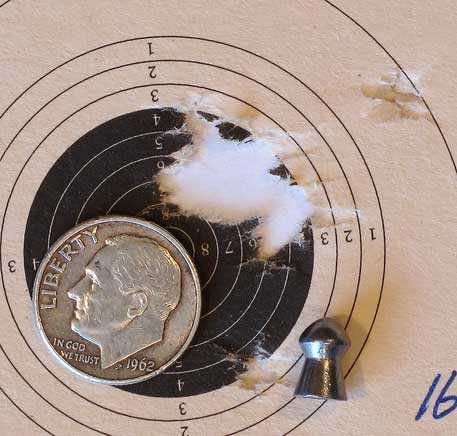
The first group was 10 H&N Baracudas shot with the same muzzlebrake setting that was used in the Part 3 accuracy test. As there were then, there were 8 tight pellets and 2 that strayed from the main group.
Like before, I got 8 shots in a good tight group and 2 that went wide. These were not called fliers, but I did feel that I wasn’t holding the gun good enough, yet.
Then, I screwed in the adjustable weight as far as it would go, which was 16 clicks. This brake adjusts in very large and definite clicks, so it’s easy to know where you are and where you’re going. The next group of 10 shots was fired with the weight adjusted all the way in.
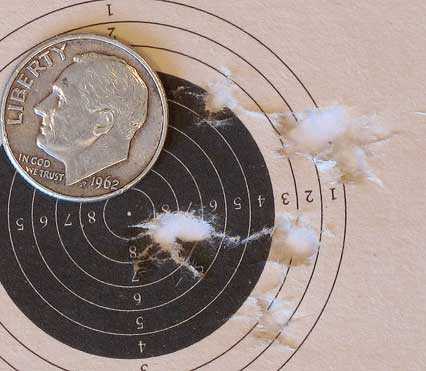
This is a tighter group than the first one; but as you can see, the pellets did not bunch up anywhere, in particular. The group measures 0.934 inches between centers.
Next, I put 16 clicks of adjustment back into the brake to see if I would get the same results as the first time. This time, no shots strayed from the main group, which measures 0.583 inches between centers. The entire group of 10 shots is close to the size of the 8 tight shots in the first group.
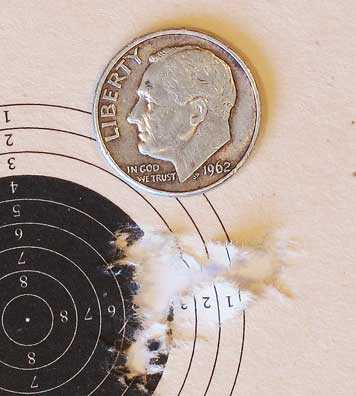
This time, every pellet went into the group. It measures 0.583 inches between centers.
While there’s some degree of repeatability in the two groups shot at the same 16-clicks out position, I didn’t feel confident that I’d seen all the performance the brake had to offer, so I turned it out 4 more clicks — a total of 20 clicks out from the beginning. Then, I shot another group. This time, there was definite group disruption, as not only were the shots scattered more openly, they also grouped into 1.192 inches.
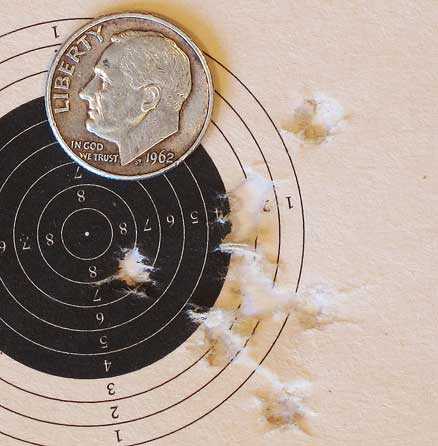
Twenty clicks of adjustment gave this open group that measures 1.192 inches between centers.
Where does that leave me?
It seemed as though the groups were opening and closing, depending on how far out the weight was adjusted. It also seems that it didn’t take much to make the groups change. But I still was not convinced.
I adjusted the weight in to the point that it had 14 clicks of adjustment, then I shot another group. This time, 9 pellets landed in a reasonably tight group that measures 0.824 inches between centers. But the tenth shot opens that to 1.346 inches — the biggest group thus far and also the largest shot during this entire test. What do I make of that?
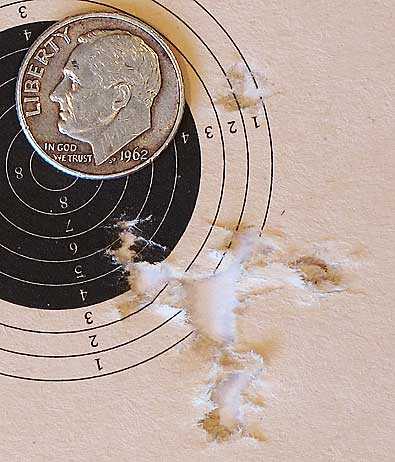
This adjustment of 14 clicks out gave a tighter group but had a lone pellet that opened the group to 1.346 inches — the largest of the entire session. What do I make of this?
The glove tells me my hold is not consistent
It was at this point that I began to feel a difference in my hold from shot to shot. The cotton glove was so slippery on the stock that I was able to feel the shape of the stock like never before. Maybe that’s what the glove is good for? I don’t know, but I went back to 16 clicks of adjustment and shot another group.
This group measures 0.913 inches between centers, but it’s different from the other groups shot on this adjustment setting. First, instead of 8 pellets bunched in one hole, this time there were only six. The other four pellets were not in the main group. The 6 that were, however, were in 0.292 inches!
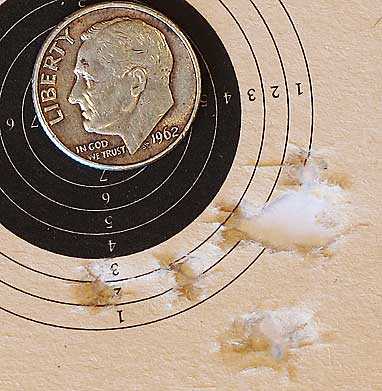
Back to 16 clicks out gave this 0.913-inch group. Within the main group are 6 pellets in a tight hole on the right, measuring 0.292 inches.
The second thing I noticed was that this group is not in the same place as the other two groups that have 16 clicks of adjustment. It’s lower on the target for some reason. While shooting this group, I definitely felt the hold was changing slightly. The R1’s stock is rounded near the triggerguard, and part of the time I had the weight pressing deeper into my off hand, while other times it was away from the center of my hand, where it seemed to want to roll to the right. I thought I needed to try one more group, and this time concentrate on centering the weight of the stock in my off hand.
I was also growing fatigued at this point, having fired 60 shots thus far. Each of those shots had taken well over one minute to set up; and as I was shooting, I remembered the person who was incredulous that I said it might take up to five minutes for each shot. Right now, the time was expanding in that direction and I was growing angry, thinking about this conversation. I wondered why anyone who ever shot off a bench did not realize that shots can take this long, when you took the time to ensure everything was perfect before releasing the shot.
And it was that anger that told me I was finished for the day. I’d shot too much. But I still plowed on, convinced that the new hold I had found might be the Holy Grail for this rifle/pellet/brake setting combination.
So, I shot one more target, using this new, weight-centered hold. I felt sure it would give me the tight groups I had been looking for. The weight was still adjusted 16 clicks out, which is the best setting I’ve found with the Baracuda pellet.
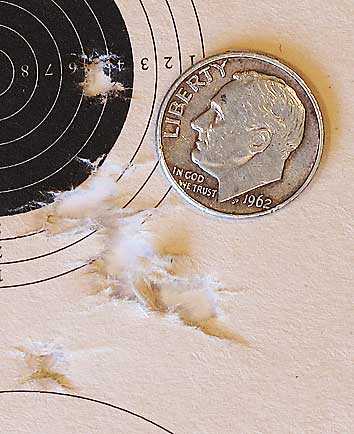
At 16 clicks out and concentrating on centering the weight of the gun in my off hand. This group measures 1.151 inches between centers and has two shots outside the main group — again! The central group of 8 shots measures 0.657 inches between centers.
It doesn’t take a graph to show that the rifle performs the same on the same weight adjustment setting. No matter how the hold is modified, the rifle wants to put 8 shots into a smaller group and have two outside shots that stretch the group size considerably.
The bottom line?
I don’t think I have a bottom line for this test, yet. I think Baracuda pellets may not be the best ones to test the gun after all. I also think I shot the gun too long in this session and tired myself out, so the final results (after about the fourth or fifth group) are suspect.
It seems clear that the adjustable brake does work, but I can’t say how well, yet. I’ll set the R1 aside for a while, but I do want to come back to it in a week or so and try it with the 15.9-grain JSB Exact domes. Maybe that’ll give me better results.

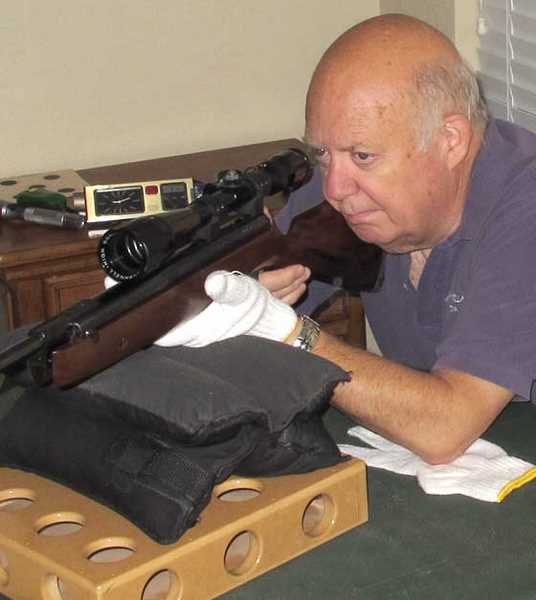
I know how you felt cocking that R1.I was sighting in my Beeman Crow Magnum last week after about 70 shots I got a shooters arm and had to put it down .[My BCM can not handle 21grain beeman kodiak pellet the breach seal wants to slip out ]
.But before ending my shootig session I grabed the R7 and put 50 pellets through it just so it relaxes me .I hate to quite frustrated.
B.B., remember our conversation at Roanoke about my Gamo changing POI? It was producing dime groups (ten shots literally covered by the dime) at 25 yards with 3 different pellets and when I came back to the first pellet I had shot it once again produced a dime size group, but the POI was to the right and lower than the first group of this pellet. As I had concluded, you too have apparently come to the conclusion that an ever so slight variation can move the POI. I sold the Gamo.
B.B.
Was the forward portion of the stock touching the bag?? The first pic seem to suggest that. Perhaps it was just the angle of the camera and the lighting.
Pete
Pete,
I know the camera angle makes it look that way, but no, there was clearance on every shot. That one was a posed shot to illustrate the Michael Jackson hold. I wasn’t actually shooting then.
B.B.
BB, did you check the parallax adjustment? Could those pellets that are out of the main group be effected by the brake as they pass through it? Looking back at the Part 3 groups, all of them had a couple pellets outside of the main group.
Mike
Mike,
I know! The fact that this gun seems to want to do that is frustrating. I don’t think the pellets are touching the inside of the brake, but that is exactly what this looks like.
So the next test will be a couple groups of Baracudas and perhaps JSBs shot with the brake off.
Thanks for the reminder!
B.B.
BB,
This is why I don’t shoot 10-shot groups :)! Seriously, the fatigue factor is high to discount. I know the arguments about statistics, but it seems to me that if a rifle can shoot good 5-shot groups all day to POA with breaks for the shooter in between, the rifle is good enough. The ten shot groups are testing the shooter, which will always be the weak link — even if he is a legend like Tom Gaylord — and not always just the accuracy of the rifle. That said, 10-shot groups are obviously good for a challenge and great practice for 5 shot groups. Do you think it would help you if are going to shoot 10 shot groups, to practice with 15 or 20 shot groups?
BG_Farmer,
No statistics discussions, except to say that 20-shot groups are a waste of time, while 10-shot groups aren’t.
I am straining against the new group of gun writers who think it’s okay to shot three-shot groups and say it represents a gun’s accuracy. Five shot groups are what I use to tell me when I need to shoot a 10-shot group or just move on.
I hate being stubborn, but I don’t want someone like me picking my results apart because I didn’t shoot enough shots per group.
B.B.
I’d think that 20 shot groups might have some value after all – in determining quality and consistency of the pellets. Or does one need more than that?
Vince,
Statistically speaking, there isn’t enough difference between 10 shots and 30 shots to make a significant difference. More is not better in this case.
B.B.
BB,
I think we’re on the same page, but just to be sure, my suggestion of 15 or 20 shot groups was to train the shooter for 10 shot groups; I realize the statistical utility is marginal.
I’ve been for and against your 10 shot policy from the beginning. I was for it before I was against it, and I’ve waffled several times 🙂 ! Practically, I shoot 3 shot groups on hunting rifles, and makes sure cold shots go to POA. Part of this is because even the cheapest c/f ammo I can get regularly is boringly accurate and 5-shot groups are a waste if groups are not my purpose.
If target shooting for group, 5 shot groups are my standard for everything, usually 5 groups of 5 will tell a compelling story. Luckily, I don’t write an internationally acclaimed blog and have to explain myself :)! I think your 10 shot groups set the bar very high, but I don’t want you to abuse yourself or open yourself up to criticism of shooting technique due to fatigue, which would certainly affect me in most cases, especially cocking a magnum springer and resettling every time. This is much like ML’er where the loading stretches out the period between shots; that can be a good thing as it gives one time to focus, but it also makes getting back into a consistent hold each time more challenging when compared to working a bolt or the like.
B.B., any of your tests are way ahead of the standard. I came across a statement in a gun magazine the other day that said, “I had a good one-hole group going with two shots but the third one opened it up.” It also seems common to post best of five shot groups (borderline) and best of three shot groups which I think is inadequate.
Five or 10 shot groups are fine but surely, the one minute+ interval for 60 shots would invoke the fatigue factor. No way could I sustain my concentration for that long. I envision practicing my shooting sequence repeatedly without huge concern for the results, and maybe sometime far in the distance, they and bullseyes will become habits that require no thought….
Matt61
B.B.,
Sadly, I haven’t read your book. I’m sure you have documented many groups with this rifle. Has it always shot with a few flyers, or is this new? I’ve heard you write (or is it read you say?) that you don’t personally clean airgun barrels until they start loosing accuracy. Maybe it’s time for a ballistol patch.
-hm
Hank,
I shot five-shot groups for the book. So all bets are off between then and now.
B.B.
33 pounds of cocking effort X 70 consecutive shots = 2,310 pounds of effort in short order. Over a ton! Wow, that’s taking one for the team.
I suspect pellets are clipping that brake. Hard to fathom another explanation for the consistent fliers. The one group without flyers is something I’ve seen even though a brake will clip pellets on a regular basis.
I had a vortek accuracy tamer once upon a time. It was the all steel version. I know these also came made out of aluminum. First time I used my all steel vortek accuracy tamer was on an R9 that was tuned to its limits. To say that gun had a buzzy and twangy shot cycle is an understatement. I remember many shooting sessions with that gun and messing with the vortek muzzle brake. One click at a time, with my all steel brake, made a difference in poi and group size. I’ve heard that the aluminum vortek accuracy tamers needed multiple adjustments for similar results. I’m guessing it’s because of the weight difference.
Interesting read.
kevin
Kevin,
I didn’t know Vortek made these in two metals. Mine is a steel one, too.
B.B.
Tom,
Steel came first but aluminum was offered later. You were given two options on his website. Aluminum of course was the cheaper version.
I also believe that Tim Wilson of custombrakz.com made knock offs of Gore’s accuracy tamers out of plastic. I’ve only seen pictures of these. Never owned one. Although they looked similar they affected harmonics by moving the entire brake back and forth as well as moving clockwise and counter clockwise. They looked great but were very crude in adjusting unlike the vortek accuracy tamer that allows tuning by just turning the knob/ring at the front. Elegant design.
Didn’t Dennis Quackenbush make you a custom, one of a kind, muzzle brake that could be adjusted to affect barrel harmonics? Did I read about it in one of the Airgun Revue’s or maybe you did an article on this blog? Hate getting old. I can’t remember anything anymore.
kevin
Kevin,
Yes! Before Tom Gore made his brake, Dennis made a brake for a Beeman Kodiak/Webley Patriot. It had a very heavy steel weight and it definitely did tighten the groups. I don’t know what has become of it, but if I ever come across it, I’ll take a picture and post it.
B.B.
Tom,
I’ve done a lot of reading about airguns and to my knowledge the adjustable brake you had Dennis make was the first designed specifically to adjust barrel harmonics. Be very interested in seeing a picture. Part of airgun history.
Please check all your warehouses where you keep your airguns and airgun parts.
kevin
Kevin,
Wilco, but I have had my eye out for this brake for some time now and I haven’t seen it yet. I wanted to do a short report on it, since it is probably the first one, as you note.
B.B.
Happy Labor Day. And B.B. is hard at it I see. I seem to have missed the description of the brake. This is some kind of sliding weight mounted on the barrel to affect harmonics?
I have my suspicions of the Michael Jackson hold, and I wonder if this is the source of the problem. I see the rationale in allowing even greater movement for the gun by letting it slide. That’s very much like recoiling artillery pieces. But I don’t know if that is a correct analogy. When I do the artillery hold, the jump is so quick and subtle that there is no sense of the gun wanting to slide in my hand. Also, the principle is repeatability; you want the gun to return to the exact same place it was when it started. But allowing the gun to slide introduces energy consuming friction. So the recoil energy is being absorbed as the gun slides back and then forward, and it will not return to the same place. Also, I execute the artillery hold through a total relaxation of the body, and I think that trying to perceive the sliding of the gun against my hand would be distracting. My own candidate for the physical center of the artillery hold is not the hand but the eye! I find that as part of follow-through if I keep my eye on target as the gun recoils, the shot will land properly. There’s some research on data visualization that I’m studying that says that the eye is very deeply hooked up with cognition so that “to see is to think.” I do kind of get the sense that if you keep the eye on target, it somehow fires the brain to correct just exactly for the shot. The eye is the gateway to the Jaws of the Subconscious! 🙂
Anyway, it is now time for B.B. to recite the line from a Bloom County cartoon. A mother is trying to dress up her 10 year old genius son, Oliver, as her own little Michael Jackson. Oliver takes the sequined glove and says, “I’m in paradise. Where’s the other one?”
In the holiday spirit, I’m thinking of good shooting vacations. Has anyone been to Camp Perry? I’m wondering if it’s worthwhile to just show up without competing. Is that necessary, worthwhile? And are there any events that people would recommend? I’m thinking of smallbore except that I may be embarrassed since I would have the good rifle but none of the other equipment. How about fun contests like the vintage sniper rifle? I suppose pistol competition would also make for a smaller logistical footprint. Airgun shows are interesting although they don’t involve much shooting. I’m not much of a hunter although the food that Kevin described is very tempting. I would make an exception for hunting the seagulls who are attacking whales in South America and would pack big heat. The other option seems to be training classes like Gunsite Tactical Pistol Shooting, although these sound expensive.
On the subject of self-defense and combat, I’m reading that the common armament in the 19th century and the Old West was bowie knife in the left hand and revolver in the right hand. You kept people off with the knife and used the revolver for anyone who got through. Seems like a good idea. Also, the high noon duel seem to have been something of an anomaly and bushwacking people was more the norm.
B.B., when I’m old, I’ll be having too much fun with my guns, knives, machetes, and combat shovels to notice whether I’m disgusting or not. 🙂 Volvo, where did you come up with the formula age/2 + 7? There are people out there with different views. Once while having lunch, I struck up a conversation with a very elderly gentleman. When he found out that I worked at a university, he asked if I was pursuing the female coeds. I told him that they were a little young for me. And then he responded energetically, “That’s what you want. That way they can be formed!!” Argh.
Matt61
Tom,
(I like using Tom rather than B.B. since it take fewer key strokes and that “.” key is sometimes hard to find)
I can identify with your open groups but I can’t help you with them. Let us know if you ever get it figured out. They were my Nemesis when I was shooting the AirgunArena online matches. They were the 8s that always killed my 10s. They were the ones that held me to 272/300 scores. BTW, during those matches we were allowed 20 minutes to make 30 shots. So, pick up the pace, will ya? 🙂
-Chuck
Can you PLEASE do another pyramydair waves? I really love listening to them.
Colt,
I’m sorry, but there simply isn’t enough interest to continue the podcast. It took many hours to prepare and the listenership was very low.
But new things are always happening, so perhaps you’ll find something to replace it.
B.B.
Guys,
at the Windsor airgun show this year, I bought a plastic container of .177 Chinese wad cutter pellets from Kevin Hold (not Kevin from Co). The clear plastic container has a green label, Hanzi writing on it and a stylized letter S. The pellets are listed at 540mg and I weigh them at around 8 gr. I shot them with my FWB 124 and was greatly surprised at the accuracy – a 5 pellet single under .3 inches c to c, at 29 feet. I’m going to try them in a few more rifles that are low power but was curious if anyone has had any experience with this pellet? Vince, you’re the Chinese master. Any comments? By the way, Pyramydair does not sell these.
Fred DPRoNJ
I’ve noticed something going on while target shooting, and wondered if this is a common experience with others here.
I’ve devised a little system using uniform targets shot at a uniform distance off a bench. I would use a variety of air guns and pellets, and keep track of scores. The idea is to establish a set of standards so the variables are limited to myself, the gun, and the pellets. Weather factors in but cannot be controlled.
While using this system for about a year, my concentration was on consistency and attempting to score as high a score as possible. Recently, my thinking has been focusing not on how many points I was scoring, but how many points I was giving up. I shoot a fixed number of shots (30) at each target, for a maximum possible score of 300. Last time out, after my first ten shots, I was thinking ” I gave up 5 points out of ten shots.”
I’ve been taught to think about only the shot I am taking at the time, not the last one or the next one. But do other target shooters usually think in terms of what they are giving up?
I also remember examining a box of Chinese pellets at a gun show in New Mexico. The plastic box was green, and the pellets had a distinct fuzzy appearance. While they were wadcutters, no two appeared quite alike. Apparently, quality control on Chinese pellets has come a long way since those were made.
No, I did not buy them.
Les
Les,
You bring up a good point.
You said and I think we all know the correct mental discipline in any shooting game is to think about the next shot “not the last one or the next one.”
It’s tough though. We’re talking about advanced shooting now. The mental discipline. Reminds me of shooting trap at the olympic center in colorado springs (50 minutes from my home). ISSF facility that is the training ground for clay shooters. They spent almost $100,000 on the house. Have a bad day at station 3 and it gets into your head.
Thanks to B.B. or rather because of his justification (never can thank him for this) I now shoot 10 shot groups. Doesn’t matter to me where in this 10 shot group it happens but when a shot opens up a group I’m mentally taken back to station 3 in Colorado Springs. In other words, no matter what happens/happened I won’t give up on the process but it’s tougher to concentrate when I know I’ve blown my best performance to date.
My personal mental exercise is to block out or forget that immediate past performance and PRETEND it was a hit. For me I learned a long time ago if I don’t dismiss or forget that shot it undermines all my subsequent shots. Works for me as silly as it sounds.
kevin
desertdweller,
The short answer for me is no, I don’t think in terms of giving up points. I haven’t had any formal training so I don’t know what I’m supposed to think about each shot. I have read before on this blog that one is supposed to think only about the current shot being made. That makes sense to me. I think that came from Vince or maybe you. I suffer from CRS – can’t remember stuff – as Kevin says he does, so forgive me guys if I don’t give credit to the right person for your good advice. Usually, when I have a nice string of rows of 9s and 10s then get an 8, I think: “Nuts, I just ruined a good score!” I don’t even think about points as such until I get out the hole measuring tool to check those that are really close to or touching the line.
Another phenomenon I have experienced (please forgive me if I’ve already written this in the past): I’ll get down to say row 5 column 3 of a thirty bull target and hit an unexplained 8. I can then go up to row one where I hit a 10 and shoot another 10 in the same hole, then go back down to the previous bad bull and shoot a one in that same hole. Now, this is telling me it’s not the pellet nor the gun, but somehow it is me.
I’m using a peep site so it’s not parallax. It can’t be fatigue because I duplicate the two shots mentioned. It must be something to do with my hold for the lower rows but I’ll be darned if I can figure out what. I haven’t tried to raise my targets higher yet (as someone mentioned on this blog in the past and I just now remembered it. I told you I have CRS.) but that might tell me something. I could be unknowingly forcing the shot to go lower, maybe.
-Chuck
I don’t think that idea came from me, although I certainly endorse it (I have CRS, too). I do know that POI changes when the angle of elevation changes.
Sometimes, for variety between shooting targets, I’ll shoot at objects placed on the ground, usually ping-pong balls. If I aim directly at the ball, I’ll usually overshoot it. But if I aim at a point just short of it, of use a 6 o’clock hold, I’ll consistently hit it. The amount of hold-under needed decreases as the ball is knocked farther away.
I do not shoot at targets in vertical columns, but my grandchildren do. The shift in POI may be linked to the shift in angle. If you are hitting at POA on the upper targets, maybe a little hold under will help keep you on target with the lower ones.
That story about the 3-shot groups was pretty funny, especially the 2-shot group stacked in the same hole. I’ve made a few of those myself, but find the 1-shot groups do better at making only one hole.
Actually, I do shoot a lot of three-shot groups. I use them when adjusting scopes.
Les
By the way: that’s NOT 5 shots IN 1 minute, but 5-shot groups, at about 1 minute each, more or less 😉 —Barrika
I am experimenting with different weights of pellets and I have weird results.
One day I have the best accuracy with one kind, next day with another.
Scope settings stay the same.
Any idea?
Yes. How high is the elevation adjusted on your scope? You describe the classic “scope shift” that’s due to a relaxed erector tube return spring allowing the erector tube to float.
Here is the way to know for sure. Adjust the scope down 80 clicks and shoot several groups. See if they aren’t tighter and don’t remain in the same place.
B.B.